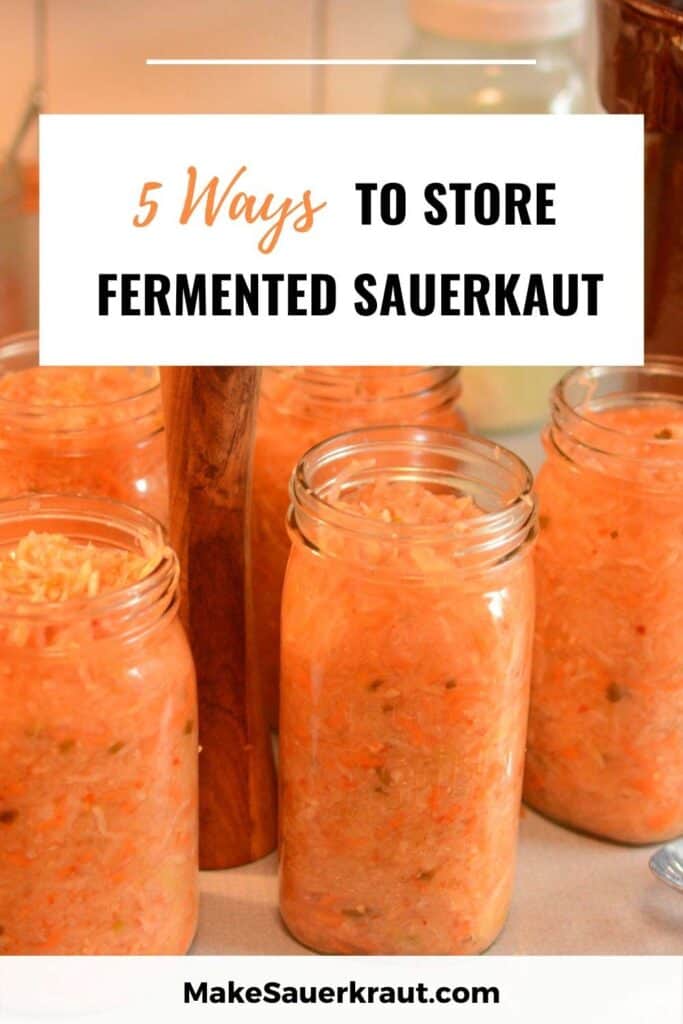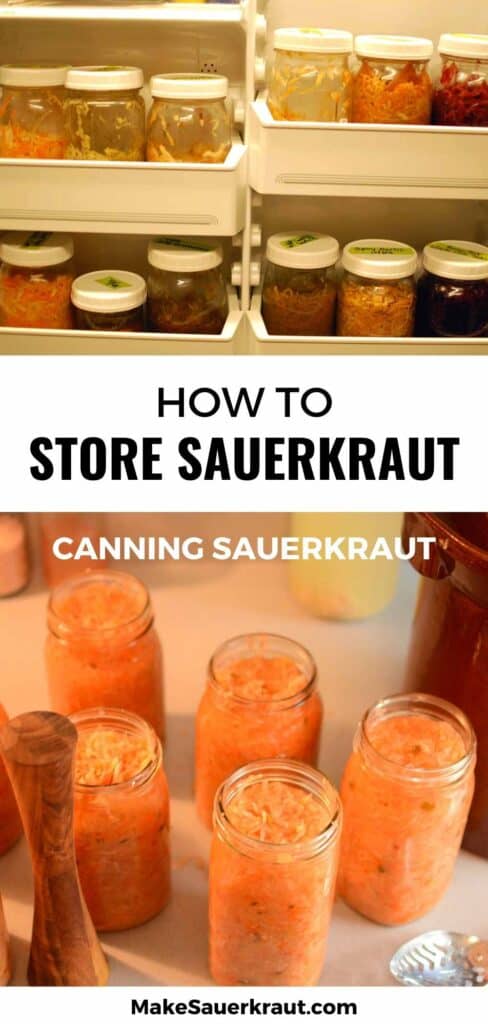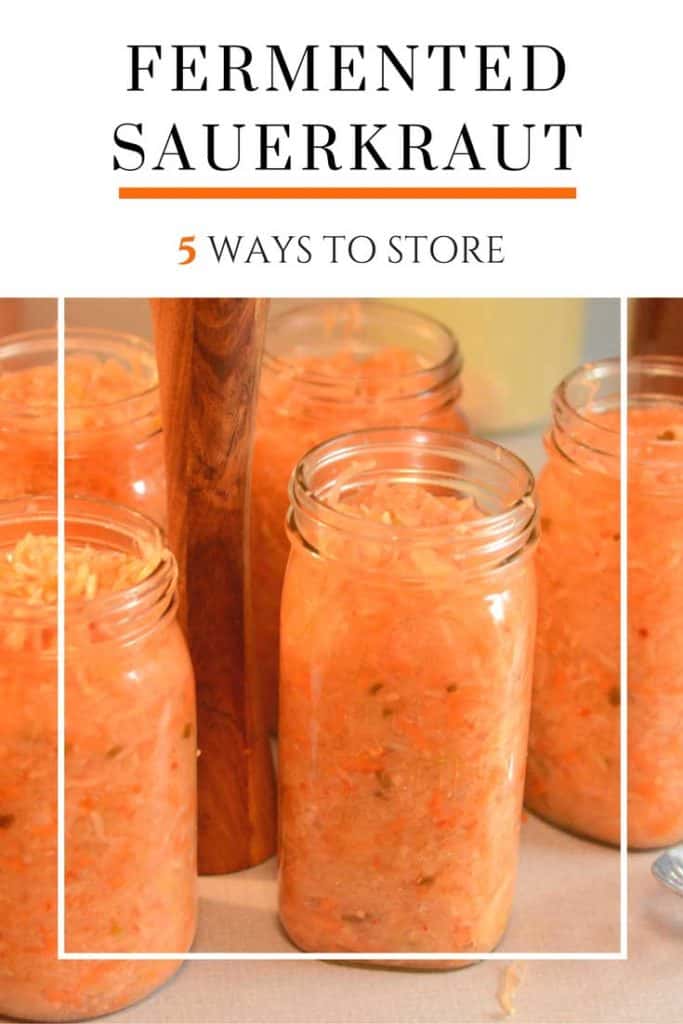Have you caught the fermentation bug?
Are you ending up with more jars of fermented sauerkraut than you have places to store them?
What’s a fermentista to do?
Storing sauerkraut can be a challenge. Many would say to can those extra jars of sauerkraut.
Wait!
Let’s not destroy all the precious bacteria created during the fermentation process if we don’t have to.
If you’re lacking space in your refrigerator to store your sauerkraut, you may think canning is your only solution, but first consider all your options:
- Canning
- Refrigerator
- Cool basement or DIY cellar
- Freezer
- Kitchen Counter
And a bonus storage tip for sauerkraut with unappetizing texture…
Dehydrating.
To begin…
- Health Benefits of Sauerkraut
- Can Your Fermented Sauerkraut to Make it Shelf Stable
- Stash Your Sauerkraut in the Refrigerator
- Find a Cool Spot to Store Your Sauerkraut as Your Ancestors May Have
- Leave Your Sauerkraut on Your Kitchen Counter
- Stash Your Sauerkraut in Your Freezer
- Dehydrate Mushy or Too Salty Sauerkraut
- The Best of Both Worlds
Health Benefits of Sauerkraut
A quick reminder here, and more here, of the goodness hidden within a jar of sauerkraut. Some of these benefits of fermented foods are destroyed by heat, others are not. Keep this in mind as you select the best way to store your sauerkraut for your situation.
Nutritional Benefits
Sauerkraut is rich in Vitamin C, Vitamin K, Vitamin B6, folate, iron, potassium, magnesium, calcium and phosphorus, Some of these vitamins and minerals are enhanced by the fermentation process and are generally retained when sauerkraut is heated or frozen.
Probiotic Benefits

Probiotics, the live bacteria that support the beneficial microorganisms in your gut, have a far-reaching positive impact.
It was for the probiotics that I learned to ferment sauerkraut and the main reason why I promote its consumption. As an added bonus, the proliferation of lactobacilli in fermented vegetables enhances their digestibility and increases absorption of their various vitamins.
The benefits of probiotics are lost when fermented sauerkraut is heated above 106° F (41.1° C). Canning is done at 180° F (82.2° C).
Don’t feel that if you cook with sauerkraut – Roasted Pork and Sauerkraut anyone? – you can’t still get the probiotic benefits of fermented sauerkraut. Just have a serving of raw sauerkraut with your meal. The best of both worlds. 😉
Benefits of feeding the trillions of microorganisms living in your digestive system:
- Increased digestive health.
The microorganisms present in fermented sauerkraut feed the good bacteria in your gut, thus improving your digestive health. - Stimulate your immune system.
Your gut is home to your immune system. In fact, the microbiome in your gut is responsible for roughly 70% of your immune system. - Eliminate inflammation.
Sauerkraut’s beneficial probiotics help increase and regulate natural killer cells to control inflammation and fight infection along with reducing food allergy reactions and giving your glowing, radiant skin. - Protect your cognitive health.
If you have experienced “butterflies in your belly” when nervous, you have experienced your gut-brain connection. Not only does your mood affect your digestion, but the health of your digestion can also affect your brain health. Happy Belly makes for Happy Brain. - Provide cancer-fighting antioxidants.
Cabbage is high in various anti-oxidants involved in the production of enzymes known for fighting free-radical damage.
Enzymes
Enzymes, which are naturally present in fresh and raw foods, are required for digestion and for all metabolic functions in the body. Enzymes are destroyed when foods are heated above 118° F (48° C).
Antioxidants
Sauerkraut contains high levels of glucosinolates, compounds shown to have anti-cancer activity. Canning sauerkraut destroys these antioxidants.
“In order for sauerkraut to have a preventative effect for cancer, it needs to be raw. Raw naturally fermented sauerkraut contains lactic acid and the living probiotic microorganisms that are the agents of fermentation. Canned sauerkraut, pasteurized sauerkraut, or fully cooked sauerkraut does not have this healing power, because the microorganisms have been killed by extended exposure to high heat. Cooking and pasteurization also damages other cancer preventative properties.” – John P. Thomas, Health Impact News
Dietary Fiber
Cabbage – fermented or fresh – is famed for its high fiber content. Fiber can help move food through the bowels, eliminating constipation, bloating, cramping, and excessive gas. Fiber’s benefits are retained when sauerkraut is heated.
Lactic Acid
Lactic acid is created during the fermentation process with the help of lactobacilli.
Lactobacilli are ubiquitous, present on the surface of all living things and especially numerous on leaves and roots of plants growing in or near the ground, such as cabbage! These bacteria eat the sugars in cabbage and produce lactic acid, which then lowers the pH to preserve your sauerkraut, inhibits the formation and growth of putrefying bacteria and give sauerkraut its tangy flavor.
As far as I can tell, lactic acid is not destroyed by heat and remains to help in digestion.
Keep these health benefits in mind as we go on to discuss 5 ways for storing sauerkraut.
[su_dropcap style=”simple” size=”1″ class=”purple”]1[/su_dropcap]
Can Your Fermented Sauerkraut to Make it Shelf Stable

At the height of the Great Depression, canned food was how many sustained their families through winter. It was common for families to raise their own meat, grains, fruits and vegetables and then can most of it.
The canning process involves placing food in jars and heating those jars to high temperatures to destroy micro-organisms that could cause food to spoil.
Naturally fermented sauerkraut is a live product full of not only beneficial bacteria with numerous health benefits. The heat of a hot water bath canner kills these beneficial bacteria.
Pros of Canning Sauerkraut
Though many of us in the fermentation world eschew canning our ferments, there are many advantages to canning. Canning your fermented sauerkraut results in a product that:
- Has an extended shelf life.
Once you have pulled those hot jars out of the canner, they will last for years. - Is easy to store.
Just place on a shelf without worrying about them spoiling. - Makes for a great emergency supply.
A shelf full of preserved food can feed many mouths for many weeks. - Retains a preferred flavor and texture.
Once the fermentation process is stopped and the sauerkraut is canned, it no longer ferments, but heat processing does give it a taste and texture all its own. - Retains many nutrients.
Vitamins and minerals are retained when sauerkraut is heated - Is easily digested.
Fermentation breaks down our foods and acts to predigest them for us. Once canned, sauerkraut is still easily digested. - Makes for an easy way to store a large harvest.
Gardeners are quite familiar with the need to quickly and safely put up a bumper crop from their garden.
Cons of Canning Sauerkraut
However, the heat involved in canning destroys any probiotic benefits of your sauerkraut. Canning:
- Kills beneficial bacteria.
The benefits of probiotics are lost when fermented sauerkraut is heated above 106° F (41.1° C). Canning is done at 180° F (82.2° C). - Kills Enzymes.
As with probiotics, enzymes – that aid in digestion – are also destroyed. - Is a lengthy, involved process.
It does take extra work and time to run a batch of jars through a canner. I love the simplicity of fermentation and am turned off by the extra step required to can my finished product. - Heats up the house.
During hot summer months, the last thing you want running all day is a hot stove. Though… most fermentation of sauerkraut is done during the cooler months, when cabbage is freshly harvested.
How to Can Fermented Sauerkraut
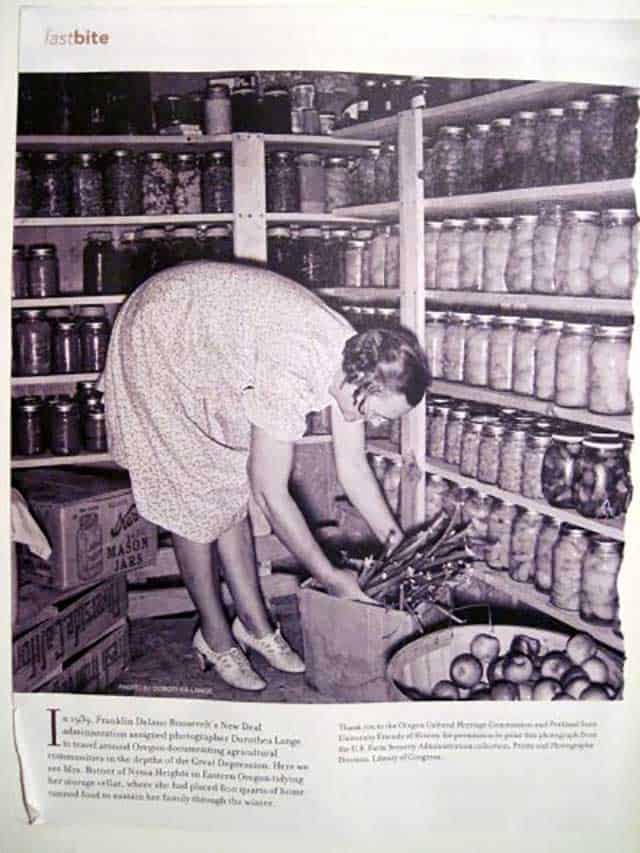
The caption reads:
“In 1939, Franklin Roosevelt’s New Deal administration assigned photographer Dorothea Lange to travel around Oregon documenting agricultural communities at the height of the Great Depression. Here we see Mrs. Botner of Nyssa Heights in Eastern Oregon tidying her storage cellar, where she had placed 800 quarts of home-canned food to sustain her family through the winter.”
As I was growing up I watched my mom standing over a hot stove for many hours in our kitchen. Quarts and quarts of peaches, pears, cherries, tomatoes, and various juices were boiled in hot water to preserve them and keep our family of six fed throughout the winter. We had a large garden and nothing went to waste. Our “tack room” – where we stored all the canned goods – looked just like the picture.
I have never canned my sauerkraut though I have canned cherries and peaches. Just can’t pass up that flavorful memory. I’m happy that my father held on all those jars we ate out of over the years and I now use them when fermenting my sauerkraut.
If you want to can your sauerkraut, this recipe by Sharon Peterson of Simply Canning gives instructions both for fermenting sauerkraut and then canning it.
She uses the same fermentation method that I do. Please be aware, however, that canning fermented sauerkraut involves a different process than canning unfermented cabbage.
“This cabbage product is safe for the waterbath only because of the fermenting you have done. Please don’t adapt this to unfermented cabbage!”
Canning Fermented Sauerkraut: Recipe
[su_dropcap style=”simple” size=”1″ class=”purple”]2[/su_dropcap]
Stash Your Sauerkraut in the Refrigerator
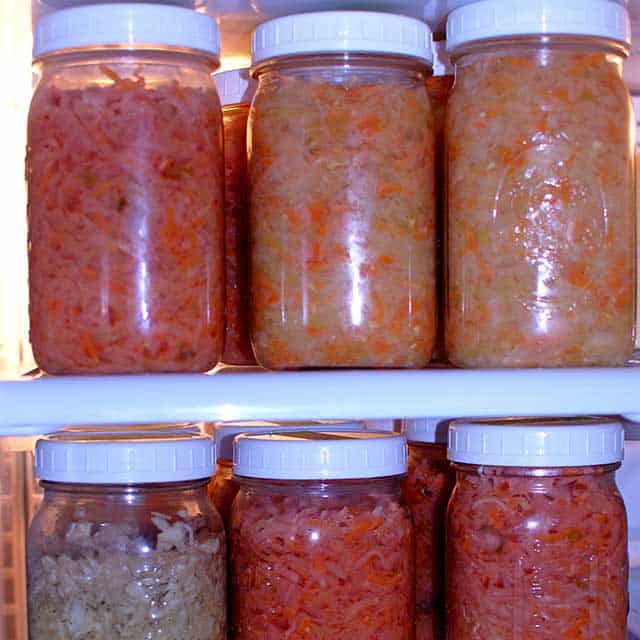
A typical refrigerator is set at 35° F (1.6° C). Properly fermented sauerkraut stored at this temperature can keep for a year without much change in texture. The flavor will continue to shift and age much like a fine wine. The coolest spot in a refrigerator is at the back of the lower shelves.
Before I moved to a house with a garage where I could keep an extra refrigerator, I fermented in a 10-liter water-sealed crock throughout the year and stored the 7-8 jars of sauerkraut that crock produced at the back of the bottom shelf of my refrigerator.
You will be amazed how much space can be found in your refrigerator by first taking a bit of time to clean it up and toss those mystery jars.
[su_dropcap style=”simple” size=”1″ class=”purple”]3[/su_dropcap]
Find a Cool Spot to Store Your Sauerkraut as Your Ancestors May Have
Many of our great ancestors fermented their sauerkraut in large crocks that they kept in their basement. Periodically, they would take off the covering, peel back any mold that may have formed and scoop out a batch of sauerkraut for the family. You’re in luck if you have a cool basement for storing your sauerkraut.
Basement
Most basements dug down into the cool earth are around 55° F (12.7° C). Properly fermented sauerkraut stored at this temperature can keep for a year with some softening as the months go on. If you have a basement then you have a great place to store your sauerkraut. Just check the temperature so you know how it will impact the texture of your sauerkraut. The cooler it is, the better.
DIY Root Cellar
Country Lore: Dig a Bucket-Sized Root Cellar – Mother Earth News https://t.co/rg5SNk6Cqx #urbanfarming #diy #food pic.twitter.com/2JCnpOIrvU
— Earth (@loveherenow) October 31, 2016
If you don’t have a basement but have a bit of space in your backyard, it is fairly easy to make your own root cellar to store quite a few jars of sauerkraut. All you need is a shovel and an old ice chest, garbage can or discarded chest freezer.
Depending on where your frost line is and if you experience freezing temperatures in your region, you should be able to maintain temperatures similar to a basement: 55° F (12.7° C). This is not quite as cold as a refrigerator but will allow you to store a season’s worth of sauerkraut.
Catherine Winter at inhabit shares a few simple backyard solutions that make use of recycled material:
Store Your Summer Harvest in a DIY Backyard Root Cellar
Flashback! Kimchi pots in Korea pic.twitter.com/ug8tppJHXR
— Jazz ODonnell (@artofstraying) September 1, 2016
In Korean, where thousands of pounds of Kimchi is made each November. Kimchi is traditionally stored in special crocks buried in the ground. Wouldn’t you love to own to of those fermentation crocks? That makes for a lot of Kimchi!
[su_dropcap style=”simple” size=”1″ class=”purple”]4[/su_dropcap]
Leave Your Sauerkraut on Your Kitchen Counter
Your sauerkraut does not have to go in the fridge. A few of my followers keep their jars on the counter, fermenting throughout the year and eating them as they are ready and enjoying the shifting flavors.
How long you can get away with this will depend upon the temperatures in your home. If properly fermented, sauerkraut will not rot or mold but the texture will slowly soften.
[su_dropcap style=”simple” size=”1″ class=”purple”]5[/su_dropcap]
Stash Your Sauerkraut in Your Freezer
The recommended temperature to set your freezer at is 0° F (-18° C). There is not much data out there, but from what I’ve recently read, freezing sauerkraut retains some, if not all, of the probiotics created during fermentation. My experience on freezing those microscopic, yet powerful bacteria indicates that the cold doesn’t kill them.
I am able to freeze whey that I then thaw and use for making fermented sodas. Works just fine. Also, the same with culturing sour cream. I save a spoonful of cultured sour cream in my freezer and then when I’m ready to make a new batch, thaw it and mix it with cream. Likewise, it cultures just fine.
I have not tried freezing my sauerkraut but have read various opinions on how it impacts texture.
“I’ve frozen kraut and never had a color issue. I opened up a bag this summer that had been at the back of the freezer for 2 years, and it was still as sour, crunchy and yellow as when it went into the bag. Even squeaked on the teeth. If I had a bigger freezer, I wouldn’t can much kraut at all.”
Pack your sauerkraut into freezer bags or in a container for freezing. Leave 1-2 inches of headspace and remove excess air for expansion. Be sure to label.
If you have a vacuum sealer, this would be a great way to remove all the air in your bag. Fermented sauerkraut can be stored in the freezer for 8-12 months. Thaw in your refrigerator.
[su_dropcap style=”simple” size=”1″ class=”purple”]6[/su_dropcap]
Dehydrate Mushy or Too Salty Sauerkraut
Make some space for the good stuff by turning the bad jars into “sauerkraut chips” or “sauerkraut spice.” Drying concentrates the nutrient content of food, along with flavors.
If you have a batch of sauerkraut that turned out too salty or you find the texture unpleasant, consider dehydrating it. You may not find it worth the extra effort as I find it much easier to just grab a fork, my jar of sauerkraut and eat to my heart’s pleasure, but it is an option.
The recipe that follows is by Amanda Feifer of Phickle and author of Ferment Your Vegetables, one of my top fermentation books.
Sauerkraut or Kimchi Spice: Turn Too-Salty Ferments into Seasoning with Punch
To retain the beneficial bacteria set your dehydrator below 106°F (41° C).
If you don’t have a dehydrator, use your oven set to its lowest temperature. On most ovens, the lowest setting is 170°F (76.7°C) – which definitely kills the lactic acid bacteria. 🙁
Forewarning: You may think your house smells when you are fermenting, dehydrating takes it to a whole new level. 😈
The Best of Both Worlds
If space for storage of jars and jars of raw sauerkraut is limited, then keep a few jars of raw sauerkraut in your refrigerator and a supply canned sauerkraut stashed in your larder. Be sure to eat a bit of the live stuff each day for the probiotics and also use your canned sauerkraut in your favorite dishes or for benefits outside of the beneficial bacteria.
Share any experience you have in the Comments about canning, freezing, dehydrating or burying your ferments. We would love to learn from your experience.
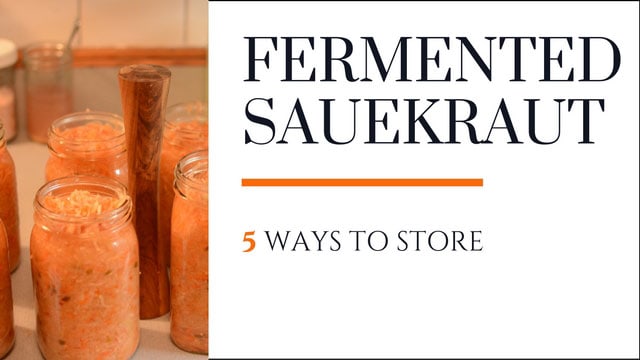
Last update on 2024-07-26 / Affiliate links / Images from Amazon Product Advertising API

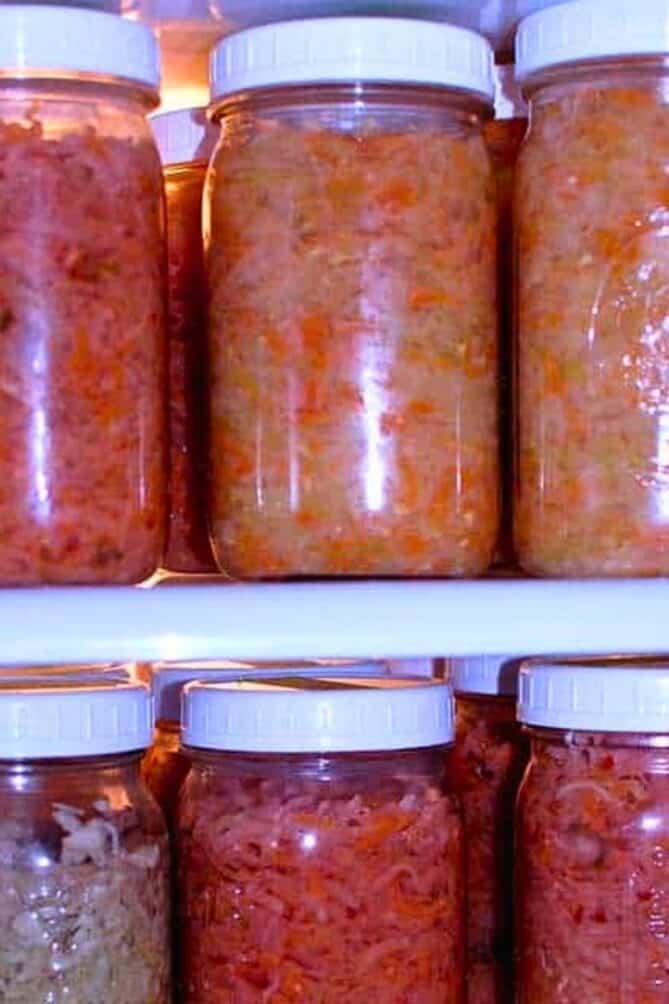

 This post may contain affiliate links which won’t change your price but will share some commission.
This post may contain affiliate links which won’t change your price but will share some commission.